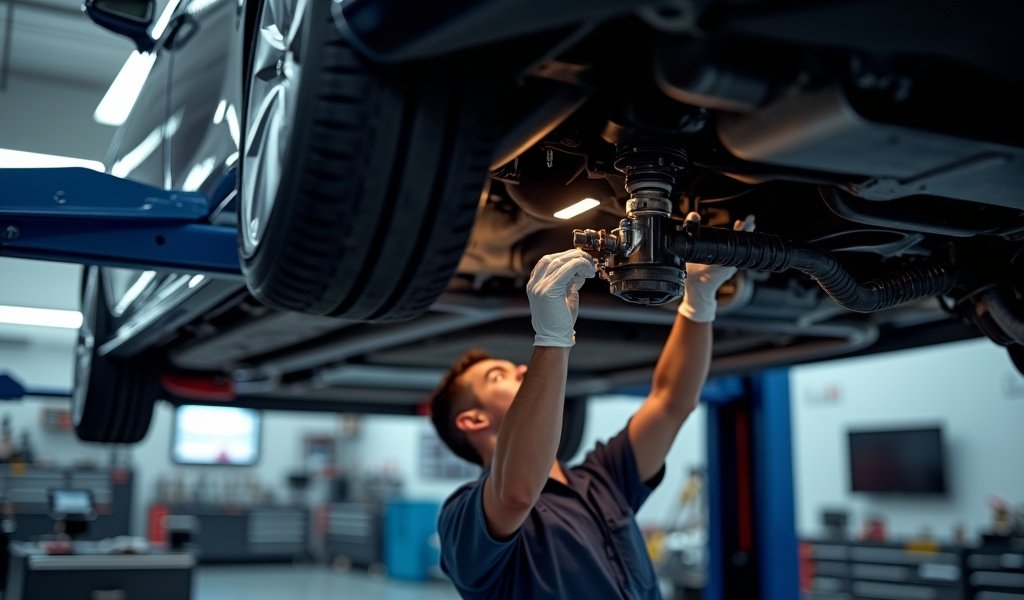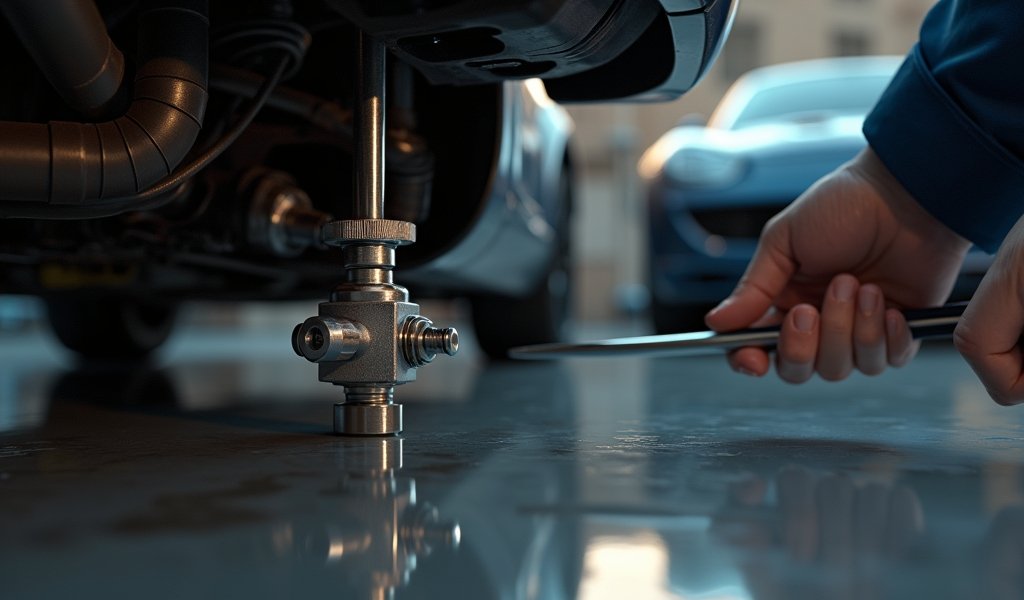Overview
This guide explains how brake proportioning valves balance braking force between front and rear wheels, with detailed instructions for diagnosing issues, making adjustments, and testing results. It covers essential tools, maintenance practices, and when to replace rather than adjust the valve, emphasizing that proper valve function is critical for safe, predictable braking performance.
Table of Contents
- Understanding Brake Proportioning Valves
- Signs of a Faulty Proportioning Valve
- Tools Needed for Adjustment
- Locating Your Brake Proportioning Valve
- Step-by-Step Adjustment Process
- Testing After Adjustment
- Maintenance Tips
- When to Replace Instead of Adjust
- Conclusion
- Frequently Asked Questions
Understanding Brake Proportioning Valves
Brake proportioning valve adjustment might sound like automotive rocket science, but I promise, it’s more accessible than you think. Like the conductor of an orchestra ensuring every instrument plays in harmony, your brake proportioning valve orchestrates the precise balance of braking force between your front and rear wheels.
In the simplest terms, this humble component prevents your rear wheels from locking up during heavy braking. When you slam on those brakes, weight transfers forward, reducing traction at the rear. Without proper proportioning, your car could pirouette like an overzealous ballet dancer on a freshly waxed stage – not exactly the graceful performance you want on the highway!
Most vehicles manufactured after the 1970s come equipped with these valves as standard safety equipment. They work by reducing hydraulic pressure to the rear brakes once the pressure reaches a predetermined threshold. This perfectly placed proportioning promotes proper performance of your entire braking system – keeping you in control when every second counts.
Modern systems have evolved from simple mechanical valves to sophisticated electronic controllers as part of anti-lock braking systems (ABS). However, many classics and even some newer vehicles still use adjustable mechanical proportioning valves that occasionally need a skilled hand to maintain that delicate balance.
Signs of a Faulty Proportioning Valve
Your vehicle has its own language for communicating problems, and when it comes to proportioning valve issues, it practically screams for attention. Like a loyal friend who’s feeling under the weather, your car will drop hints when this crucial component isn’t performing as it should.
The most telltale sign is uneven braking. If your car pulls dramatically to one side when you press the brake pedal, your proportioning valve might be whispering (or shouting) for help. Similarly, if your rear wheels lock up before the fronts during hard braking – creating that heart-stopping skid – that’s another red flag waving frantically in your face.
Other symptoms include:
- Unusually long stopping distances that make every red light an adventure
- Brake pedal that feels as spongy as week-old cake
- Rear brakes that wear out faster than a child’s patience on a long road trip
- ABS warning light glowing on your dashboard like an unwelcome holiday decoration
According to NHTSA’s vehicle safety division, improper brake balance contributes to thousands of accidents annually. Isn’t it time you gave your car the care it deserves rather than gambling with those precious stopping feet?

Tools Needed for Adjustment
Before diving into the mechanical symphony of brake proportioning valve adjustment, let’s gather our instrumental tools. The process is as simple as following a recipe – but only if you have all the ingredients laid out before you begin.
First and foremost, you’ll need a quality jack and jack stands – because working under a vehicle supported only by hopes and dreams is a terrible idea. Safety first, my friends; your family will thank you for it.
Here’s your complete shopping list:
- Jack and jack stands rated for your vehicle’s weight
- Wheel chocks (the unsung heroes of vehicle maintenance)
- Brake bleeding kit (typically a clear tube and container)
- Wrench set (combination and/or socket set)
- Proper brake fluid (check your vehicle’s manual – type matters!)
- Clean rags (because things will get messy)
- Small adjustable wrench or specialized proportioning valve tool
- Flashlight (the mechanic’s best friend)
- Safety glasses (because eyes are irreplaceable)
For the weekend warrior, this might seem like I’ve told you a million things to gather, but each tool plays a crucial role in this delicate adjustment process. Remember that choosing the right brake components, including proper fluid, makes all the difference between a successful adjustment and creating more problems.
Locating Your Brake Proportioning Valve
Finding your vehicle’s brake proportioning valve is sometimes like a mechanical treasure hunt – rewarding but occasionally challenging. In most vehicles, this crucial component nestles near the master cylinder, often mounted on the firewall or frame rail, though some manufacturers seem to delight in hiding it in the most obscure locations.
Generally, you’ll find it along the brake line path between the master cylinder and the rear brakes. It might appear as a small metal block with brake lines entering and exiting, or in older vehicles, as a spring-loaded device attached to the rear axle or frame.
Vehicle-specific locations include:
- American sedans and trucks: Often mounted to the master cylinder or nearby on the firewall
- European vehicles: Frequently tucked along the frame rail under the driver’s side
- Japanese models: Commonly positioned near the ABS module or integrated into it
- Older rear-wheel-drive vehicles: Look for a load-sensing proportioning valve near the rear suspension
If your automotive hide-and-seek skills aren’t yielding results, specialized repair manuals provide detailed diagrams for your specific make and model. Remember, modern vehicles with electronic brake force distribution may not have a traditional adjustable valve – these systems rely on computer-controlled solenoids that require specialized diagnostic equipment.
Step-by-Step Adjustment Process
With tools in hand and your proportioning valve located, let’s dance through the adjustment process. This mechanical waltz requires patience and precision – rush through these steps and your brakes might throw a tantrum when you least expect it.
First, ensure your vehicle is safely supported on level ground, with wheels chocked and the parking brake engaged. Your car should be as stable as your favorite mechanic’s work ethic.
-
Preparation: Locate the adjustment screw or nut on the proportioning valve. This might require removing a protective cap or lock nut. Take a quick photo with your phone before disturbing anything – this digital breadcrumb trail can save you hours of confusion later.
-
Current Setting: Note the current position of the adjustment mechanism. Count the turns or measure the distance as you adjust so you can return to original settings if needed. This step is as crucial as remembering where you parked at the shopping mall.
-
Make the Adjustment: Using the appropriate tool, make small adjustments – typically clockwise to increase rear brake pressure or counterclockwise to decrease it. The golden rule: make quarter-turn adjustments, then test. Aggressive adjustments can transform your predictable sedan into an unpredictable drifting machine.
-
Bleed if Necessary: If the system was opened, you’ll need to bleed air from the brake lines. Air in brake lines is like anxiety on a first date – it makes everything perform poorly under pressure.
For mechanical load-sensing proportioning valves (often found on older trucks and SUVs), the adjustment may involve altering spring tension or the position of a lever arm connected to the rear suspension. According to expert brake technicians, these adjustments should correspond to the vehicle’s typical load range.

Testing After Adjustment
After dancing with your proportioning valve, it’s showtime – testing your handiwork requires both caution and thoroughness. Your vehicle’s braking system is now like a finely tuned instrument, but even virtuosos need to warm up before the big performance.
Begin in a safe, open area – an empty parking lot is ideal. Start with gentle brake applications at low speeds, feeling for any pulling or uneven braking. Gradually increase both speed and braking force, but remember that true testing requires various conditions.
Pay particular attention to:
- Straight-line stopping (the brake pedal should feel firm and the car should track straight)
- Stopping on various surfaces (both smooth and slightly rough pavement)
- Light versus panic-stop braking (the transition should be predictable)
- Wet-weather performance (if safely possible)
Your rear wheels should never lock up before the fronts – this indicates excessive rear brake pressure and could send you sliding sideways like a hockey puck on fresh ice. Conversely, if the vehicle nose-dives dramatically during braking while the stopping distance seems excessive, rear brake pressure might be insufficient.
The perfect adjustment will make your vehicle stop as predictably as sunrise, with minimal drama and maximum control. If something feels off, don’t hesitate to readjust or consult a professional. After all, brakes aren’t something to experiment with like your grandmother’s secret recipe.
Maintenance Tips
Maintaining your proportioning valve is less about constant tinkering and more about vigilant observation. Like an attentive parent watching for signs of a fever, you should regularly check for symptoms of proportioning valve distress during your normal driving routine.
Incorporate these simple practices to keep your brake balance in harmony:
- Inspect brake fluid levels and condition monthly – dark, cloudy fluid begs for replacement
- Listen for unusual noises during braking – they’re your car’s way of raising a mechanical eyebrow
- Pay attention to brake pedal feel – changes in pressure or travel distance are telling signs
- Check for leaks around the proportioning valve and connected brake lines during routine oil changes
- Document any adjustments made in your vehicle maintenance log – your future self will thank you
Environmental conditions can affect brake performance more than you might think. In regions where temperatures swing dramatically or roads are salted during winter, corrosion can affect valve operation. A light coating of appropriate brake system lubricant on external adjustment points (never on internal components) can prevent seizing in these climates.
Remember that brake systems work as an integrated unit. Maintaining proper brake pad condition and rotor health contributes to overall system balance. Even the most perfectly adjusted proportioning valve can’t compensate for worn pads or warped rotors.
When to Replace Instead of Adjust
Even the most skillful adjustment won’t resurrect a proportioning valve that’s gone to the great auto parts store in the sky. Like an old loyal dog that can no longer fetch, some valves simply reach the end of their serviceable life.
Consider replacement rather than adjustment when:
- You spot fluid leaking from the valve body or connections
- Adjustment makes no noticeable difference to braking performance
- The valve is visibly corroded or damaged
- Your vehicle has over 150,000 miles on the original valve
- Braking feels inconsistent even after proper adjustment and system bleeding
Modern replacement valves often offer improved designs over original equipment, particularly for classic vehicles. The automotive aftermarket has developed adjustable proportioning valves that provide finer control than factory units, especially valuable for modified vehicles or those used in performance applications.
When selecting a replacement, match hydraulic pressure ratings and port configurations to your specific vehicle. The cost typically ranges from $50 for basic OEM-style replacements to $200+ for premium adjustable units. While this might seem steep, consider it an investment in the most critical safety system on your vehicle. As they say in the brake business, “If you think quality parts are expensive, try having an accident.”
Conclusion
Brake proportioning valve adjustment isn’t just mechanical maintenance—it’s an investment in your vehicle’s safety performance. Like a guardian angel riding shotgun, a properly adjusted valve ensures predictable, balanced braking when you need it most.
We’ve journeyed through understanding what these valves do, spotting when they need attention, gathering the right tools, finding them in your vehicle’s mechanical maze, making precise adjustments, and testing the results. This knowledge transforms you from passive driver to informed vehicle owner—someone who understands that proper stopping power is about more than just pressing a pedal.
Whether you decide to tackle this adjustment yourself or entrust it to a professional, understanding the process empowers you to make better decisions about your vehicle’s maintenance. And remember—braking systems don’t exist in isolation. From properly selected brake pads to well-adjusted proportioning valves, every component plays its part in the symphony of safety that protects you and your passengers.
So the next time you bring your vehicle to a smooth, controlled stop, give a little nod of appreciation to that humble proportioning valve—the unsung hero of balanced braking that’s working tirelessly to keep your journeys safe.
Frequently Asked Questions
How often should I adjust my brake proportioning valve?
Most proportioning valves rarely need adjustment unless you modify your vehicle or notice braking issues. Check it during major brake service (every 50,000 miles) or if braking feels unbalanced.
Can I drive with a faulty proportioning valve?
While technically possible, it’s extremely dangerous and not recommended. A faulty valve can cause unpredictable braking, rear wheel lockup, and significantly increased stopping distances.
Do all vehicles have adjustable proportioning valves?
No, many modern vehicles use electronic brake force distribution within the ABS system instead of adjustable mechanical valves. Consult your vehicle’s service manual to determine your specific system type.
How much does professional proportioning valve adjustment cost?
Professional adjustment typically costs between $75-150 depending on your location and vehicle. This service is often included in a complete brake system overhaul.
Can I install an aftermarket adjustable proportioning valve?
Yes, aftermarket adjustable valves can be installed on most vehicles and are particularly useful for modified cars with altered weight distribution. Ensure the valve matches your vehicle’s hydraulic pressure requirements.


Pingback: Brake System Hydraulic Pressure: 7 Tips - knowsyourcar.com